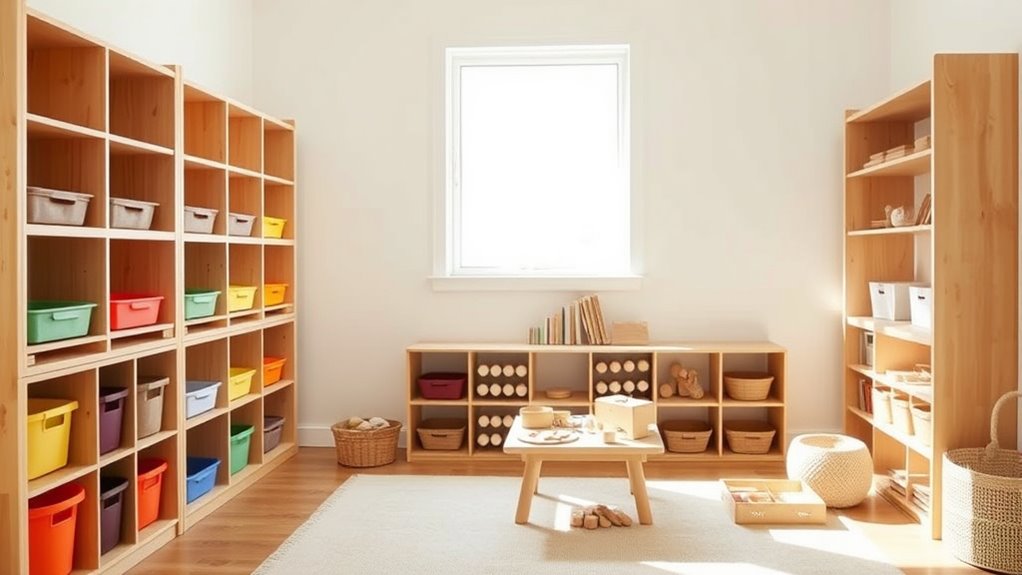To set up Montessori at home for your toddler, create organized, child-friendly spaces with low shelves for easy access and clear storage. Include art stations, sensory bins with everyday materials, and practical life areas with real objects like utensils or fabrics. Design outdoor areas to encourage exploration, and rotate toys regularly to keep your child engaged. If you explore these simple setups further, you’ll discover even more ways to foster independence and curiosity.
Key Takeaways
- Use low, accessible shelving and labeled containers to promote independence and organization.
- Create dedicated art and sensory zones with materials at child’s eye level for self-directed exploration.
- Set up practical life areas with household items to develop motor skills and daily routines.
- Design toy zones with rotation and seasonal updates to maintain engagement and curiosity.
- Ensure all materials are safe, non-toxic, and layered with textures to support tactile and sensory development.
Clear and Accessible Shelving for Self-Selection

Having clear and accessible shelving is essential for encouraging your toddler’s independence and curiosity. When you organize with visual accessibility in mind, your child can easily see and select their toys and materials without assistance. Use low shelves that are within their reach, keeping everything at eye level to promote self-directed learning. Implement organization strategies like grouping similar items together and using open bins or baskets for quick identification. This setup not only makes cleanup easier but also empowers your toddler to make choices confidently. Clear labeling or simple visual cues can enhance understanding, helping them navigate their space independently. Additionally, choosing the right visual cues ensures that your child can easily identify and select materials, fostering autonomy. By creating an inviting, organized environment, you foster autonomy and stimulate your child’s natural desire to explore and learn. Incorporating creative practice into your daily routines can further support their development and curiosity.
Low-Mounted Art and Creativity Stations

Setting up low-mounted art and creativity stations invites your toddler to explore their artistic talents independently. By creating designated creative zones, you give them easy access to supplies like crayons, markers, paints, and paper. Position an art display at their eye level so they can proudly showcase their masterpieces and feel motivated to create more. Keep materials organized and within reach, encouraging self-directed activity without constant adult intervention. These stations foster autonomy, fine motor skills, and self-expression while making art enjoyable and accessible. When your toddler can freely choose and put away supplies, they develop independence and a sense of responsibility. Incorporating Self Watering Plant Pots into your setup can help you create engaging and successful creative spaces that resonate with your child’s interests. Additionally, observing market trends and insights can inform how you adapt your setup to current developmental needs and interests. Low-mounted art and creativity stations turn your space into a vibrant hub for imagination and learning.
Practical Life Areas With Daily Materials

Creating practical life areas with daily materials allows your toddler to develop essential skills through meaningful, everyday activities. These setups encourage fine motor skills as your child learns to pour, zip, button, and scoop with simple household items. As they practice these tasks, they gain confidence and independence. Practical life activities also foster social interaction, especially when you involve family members or friends, teaching your toddler cooperation and patience. By using items like small baskets, cloths, and utensils, you create accessible opportunities for your child to engage in real-life tasks. This hands-on approach not only builds physical coordination but also cultivates a sense of responsibility and self-sufficiency that supports their overall growth. Incorporating electric bikes and related technology into your environment can also inspire curiosity and an appreciation for their surroundings. Recognizing the importance of AI’s societal impact, parents can also introduce simple tech tools that promote problem-solving and critical thinking during play.
Organized Toy Zones for Focused Play

Creating organized toy zones helps your toddler focus and develop independence. Use clear storage containers so they can see and choose their toys easily. Make sure play areas are well-defined and the toys are accessible to encourage self-directed play. Incorporating organized systems can also streamline cleanup and foster routine.
Clear Storage Containers
Have you ever noticed how clutter can make it hard for toddlers to focus during play? Using clear storage containers helps keep toy organization simple and accessible. They allow your child to see exactly what’s inside, promoting independence. To maximize effectiveness:
- Label each container with clear, simple words or pictures for easy material labeling.
- Choose sizes that fit the toy types—small for blocks, larger for plush toys.
- Keep containers at your child’s height for easy access.
- Regularly tidy and reassess to remove unused toys and maintain a clutter-free zone.
- Incorporate rustic decor elements into your storage solutions to create a warm, inviting atmosphere that aligns with farmhouse style. Being aware of child-friendly organization principles can further enhance the safety and usability of your setup.
This setup encourages your toddler to choose and return toys independently, fostering responsibility and focus. Clear storage containers are key to creating organized toy zones that support Montessori principles.
Defined Play Areas
Organized toy zones help your toddler focus during play by providing clearly designated areas for different activities. When you set up defined play areas, you create spaces for interactive storytelling, music, and movement. For example, designate a corner for picture books and storytelling props to encourage language development and imagination. Nearby, set up a small area with musical instruments and space for movement to foster physical coordination and rhythm. Keeping each zone tidy and purposeful helps your toddler understand boundaries and minimizes distractions. This structured environment supports focused engagement, making playtime more meaningful. By clearly separating activities, you help your child develop concentration and independence while enjoying diverse, enriching experiences within your home. Incorporating child-friendly furniture into these zones can further enhance safety and accessibility for your little one.
Accessible Toy Selection
Why is it important to choose accessible toys for your toddler? When toys are within easy reach, your child can independently select and engage, fostering confidence and decision-making. An organized toy zone encourages focused play and minimizes distractions. Consider these tips:
- Use low shelves or bins so your toddler can see and reach all toys easily.
- Incorporate toys that promote interactive storytelling, like puppets or figurines, to spark imagination.
- Include musical instruments, like a small drum or xylophone, for sensory exploration and rhythm.
- Rotate toys regularly to keep interest high and make space for new, purposeful activities.
Sensory Bins Using Everyday Items

When creating sensory bins with everyday items, make sure to choose safe, non-toxic materials your toddler can handle easily. Try filling and layering different textures or colors to spark their curiosity and promote exploration. You can also encourage sorting skills by guiding them to group similar objects, making play both fun and educational. Incorporating educational content into sensory play can further enhance their learning experience. Additionally, understanding how Glycolic Acid benefits work can inspire you to introduce concepts of financial literacy in age-appropriate ways as part of broader learning activities.
Selecting Safe Materials
Choosing safe materials for sensory bins is essential to guarantee your toddler’s safety while they explore and learn. Start by child proofing furniture to prevent accidents. Next, select items made with non-toxic paint choices to avoid harmful chemicals. When gathering materials, consider these options:
- Use everyday household items that are free of small parts to prevent choking.
- Opt for natural textures like dried beans, rice, or pasta instead of synthetic fillers.
- Avoid sharp or breakable objects to prevent injuries.
- Regularly inspect items for wear or damage, replacing anything unsafe.
- Incorporate child-friendly, non-toxic materials to ensure a safe sensory experience for your toddler.
- Pay attention to vibrational energy to create a calm and positive environment during exploration.
Filling and Layering Ideas
Filling and layering sensory bins with everyday items offers a simple way to create engaging learning experiences at home. You can encourage color matching by selecting objects in similar hues, helping your toddler develop their visual discrimination. Incorporate different textures—smooth stones, soft fabric, rough pinecones—to promote texture exploration, which enhances sensory awareness. Layer items thoughtfully to introduce concepts like size, shape, or pattern, making the activity more enriching. For example, place soft items on top of harder ones or arrange objects by color or texture. This setup keeps your toddler curious and encourages fine motor skills as they grasp, sort, and explore each layer. Keep the activity simple, safe, and adaptable to your child’s interests and developmental stage.
Encouraging Exploration and Sorting
Encouraging exploration and sorting with sensory bins using everyday items invites your toddler to engage actively with their environment. These bins foster musical exploration and texture sorting, enhancing sensory development. For example:
- Fill a bin with dried pasta or rice for tactile play and sound exploration.
- Add small musical instruments like shakers or bells for musical exploration and auditory feedback.
- Include different textured objects—smooth stones, rough shells, soft fabric squares—for texture sorting.
- Incorporate spoons and cups to promote scooping, pouring, and fine motor skills.
Nature-Inspired Exploration Spaces

Have you ever noticed how a simple patch of grass or a cluster of leaves can spark a child’s curiosity? Creating nature-inspired exploration spaces at home encourages this wonder. Use garden pathways to guide your toddler through different sensory experiences, like feeling textured stones or sniffing fragrant herbs. Incorporate outdoor shelter options, such as a small tent or canopy, where children can observe insects or read books surrounded by nature. These setups foster independence and curiosity while connecting your child to the environment. Keep the area simple and accessible, ensuring it’s safe for little explorers. By integrating natural elements and inviting spaces, you give your toddler opportunities to learn through direct contact with the outdoors, nurturing their innate desire to discover and understand the world around them. Regularly assess and organize outdoor areas to maintain a safe and stimulating environment.
Rotation and Refreshing of Materials

As children explore their natural environment, their curiosity naturally shifts toward discovering new objects and ideas. To keep their interest alive, it’s important to rotate and invigorate materials regularly. Seasonal changes offer a perfect opportunity for themed rotations, making activities relevant and engaging. Here are four tips:
Rotating seasonal materials keeps children curious, engaged, and eager to explore new ideas and objects.
- Swap out materials based on seasons, like autumn leaves or winter scarves.
- Introduce themed sets, such as farm animals or beach toys, to spark specific interests.
- Limit access to materials at one time, then rotate them weekly or biweekly.
- Observe your child’s preferences and adjust the materials accordingly.
This approach keeps their environment stimulating and encourages ongoing exploration, helping them develop independence and focus. Invigorating materials ensures your toddler remains curious and engaged in their learning journey.
Frequently Asked Questions
How Can I Involve My Toddler in Setting up Their Montessori Space?
You can involve your toddler in setting up their Montessori space by encouraging child-led activities and DIY involvement. Let them choose materials and arrange their space, fostering independence and decision-making. Guide them gently, offering simple steps for DIY setups, like assembling shelves or choosing toys. This hands-on approach makes them feel empowered and excited about their environment, promoting a sense of ownership and curiosity in their learning space.
What Safety Considerations Are Important for DIY Montessori Materials?
Imagine your toddler’s DIY Montessori materials turning into mini hazards—yikes, right? To prevent that, always opt for non-toxic finishes to keep things safe if chewed or mouthed. Make certain everything is securely mounted to avoid tipping or falling. Regularly check for loose parts or wear and tear, because safety isn’t just a suggestion, it’s a necessity, especially when little hands are involved.
How Often Should I Rotate Montessori Materials at Home?
You should rotate Montessori materials at home every 2 to 4 weeks to keep your toddler engaged and prevent boredom. Regular material maintenance guarantees they stay safe and functional, while proper storage organization makes it easy to swap materials efficiently. Observe your child’s interest; if they lose focus or seem uninterested, it’s a good sign to introduce new materials or rotate existing ones to maintain their curiosity and learning momentum.
Can I Adapt Montessori Setups for Different Toddler Ages?
Think of Montessori setups as a flexible garden that blooms with your child’s growth. Yes, you can adapt activities for different toddler ages by tailoring age-appropriate activities and using adaptable furniture that grows with them. As your toddler blossoms, shift materials to match their evolving skills, ensuring each space nurtures independence and curiosity. This fluid approach keeps their environment vibrant, engaging, and perfectly suited to their developmental journey.
What Are Affordable Alternatives for Montessori-Inspired Furniture?
You can find affordable alternatives for Montessori-inspired furniture through DIY solutions and budget shopping. Repurpose household items like crates or wooden shelves for storage and learning areas. Check thrift stores or discount outlets for small furniture pieces that suit your child’s size and needs. With a little creativity, you can create a functional, Montessori-friendly environment without overspending, making learning simple and accessible at home.
Conclusion
With each thoughtfully arranged space, you craft a garden where your toddler’s curiosity blooms and independence takes root. Like a gentle breeze guiding a butterfly, your simple setups nurture little explorers to spread their wings. As materials flow smoothly and discovery becomes a daily dance, you create a harmonious environment where learning blossoms naturally. Embrace this gentle rhythm, and watch your child’s world flourish with wonder and joy, right in the comfort of your home.










